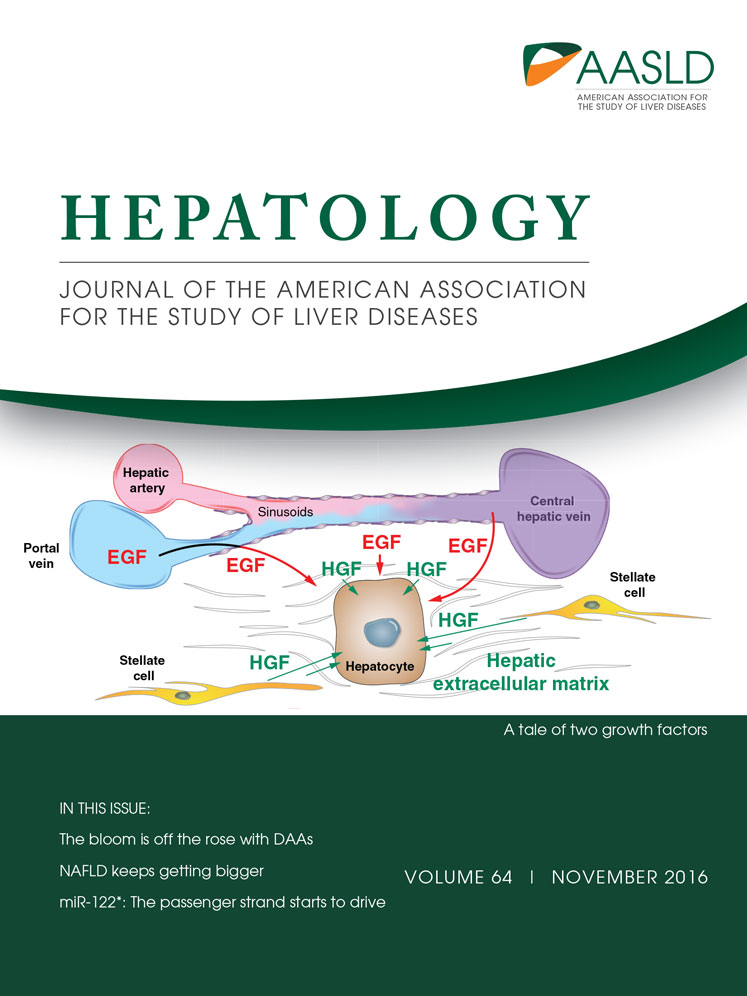Treating hepatitis B virus/hepatitis C virus coinfected patients with direct-acting hepatitis C virus antivirals only is not safe
Potential conflict of interest: Nothing to report.
Direct-acting antivirals (DAAs) enabled cure of chronic hepatitis C (CHC) in high rates with acceptable tolerability. Hepatitis B (HBV) and C virus (HCV) coinfected patients may not benefit if only CHC is treated with DAAs. We reviewed the medical literature and noticed 4 cases (Table 1).
| Author (Reference) |
Age (years) |
Sex | HBV Profile | HCV Profile | Disease Severity | HCV Treatment | HBV Flare | HBV Treatment | Outcome | Remarks | ||
|---|---|---|---|---|---|---|---|---|---|---|---|---|
| Time After HCV Treatment | Highest ALT | Highest HBV DNA | ||||||||||
| Takayama et al.(1) | 69 | Male |
HBsAg(+) HBeAg (−) HBV DNA 2.5 log copies/mL |
Genotype 1b HCV RNA 4.2 log IU/mL | Non cirrhotic | Daclatasvir+ asunaprevir | 43 days | 237 U/L | 7.0 log copies/mL | Entecavir | Flare improved | Although HCV therapy was discontinued at day 43, it provided SVR. |
| Collins et al.(2) | 55 | Male |
HBsAg (+) HBV DNA 2,300 IU/mL |
Genotype 1a HCV RNA 1,300,000 IU/mL |
Child Pugh class A cirrhosis | Sofosbuvir+ simeprevir | 8 weeks | 1,495 U/L | 22,000,000 IU/mL | Tenofovir/emtricitabine | Flare improved | Although HCV therapy was discontinued at week 8, it provided SVR. |
| Collins et al.(2) | 57 | Male |
HBsAg (−) Anti-HBs (−) Anti-HBcIgG(+) HBV-DNA <20 IU/m |
Genotype 1a HCV RNA 8,600,000 IU/mL | Non cirrhotic | Sofosbuvir+ simeprevir | 4 weeks | Normal | 11,255 IU/mL | Tenofovir | HBV DNA (−) after 8 weeks of tenofovir | HCV therapy was continued to 12 weeks and it provided SVR. |
| Ende et al.(3) | 59 | Female |
HBsAg (−) Anti-HBs (−) Anti-HBcIgG(+) HBV DNA (−) |
Genotype 1b | Stage 2/4 fibrosis | Sofosbuvir+ simeprevir | 11 weeks | 2,263 U/L | 29,000,000 IU/mL | Tenofovir | She developed liver failure and underwent liver transplantation. | HCV therapy provided SVR. |
- Abbreviations: HBeAg, hepatitis B e antigen; anti-HBs, hepatitis B surface antibody; SVR, sustained virological response.
Takayama et al. described an HBV reactivation after use of daclatasvir and asunaprevir on day 15 with alanine aminotransferase (ALT) of 237 IU/mL.1 Baseline HBV-DNA of 2.5 log copies/mL increased to 7 logs copies/mL. Entecavir initiated after day 50 controlled HBV flare.
Collins et al. described 2 coinfected patients2: Eight weeks after sofosbuvir and simeprevir, ALT increased to 1,495 IU/L and total bilirubin to 12.2 mg/dL. Tenofovir/emtricitabine combination controlled HBV flare. Another patient, a 57-year-old male, had HCV and isolated anti-HBcIgG (hepatitis B core immunoglobulin G antibody) positivity. At week 2 of sofosbuvir and simeprevir treatment, HBV DNA increased to 353 IU/mL and in week 4 to 11,255 IU/mL. Tenofovir was added for HBV reactivation.
Another report described liver failure after using HCV drugs for a coinfected patient.3 A 59-year-old female had HCV and isolated anti-HBcIgG positivity. She was given simeprevir, sofosbuvir, and ribavirin. In week 11, ALT increased to 2,263 U/L, total bilirubin was 9.1 mg/dL, and international normalized ratio (INR) was 1.9. Repeated testing showed hepatitis B surface antigen (HBsAg) positive and HBV DNA 29,000,000 IU/mL. Tenofovir was initiated on the third day of HBV reactivation. However, she became encephalopathic with a rising INR and underwent liver transplantation.
HBV/HCV coinfection usually follows a course of HCV dominance. The HCV core inhibits HBV replication and HBsAg expression. Secretion of the HBV and viral proteins is significantly reduced in the presence of HCV core or nonstructural 2 (NS2) protein.4
Because DAAs have no effect on HBV replication, the flare is observed weeks after initiation of therapy. Limited experience with HBV/HCV coinfected patients shows that either HBV-DNA levels should be monitored closely or HCV drugs should be used combined with HBV treatment. Close monitoring and early recognition of reactivation may prevent severe flare or liver failure.
-
Resat Ozaras, M.D.1
-
Mustafa Sunbul, M.D.2
-
Mehmet Parlak, M.D.3
-
Hurrem Bodur, M.D.4
-
Hakan Leblebicioglu, M.D.2
-
1Department of Infectious Diseases
-
Istanbul University
-
Cerrahpasa Medical School
-
Istanbul, Turkey
-
2Department of Infectious Diseases
-
Ondokuz Mayis University Medical School
-
Samsun, Turkey
-
3Department of Infectious Diseases
-
Ataturk University
-
Medical School
-
Erzurum, Turkey
-
4Ankara Education and Teaching Hospital
-
Ankara, Turkey




